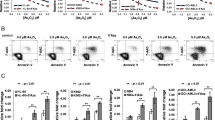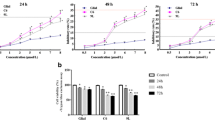Abstract
Arsenic trioxide (As2O3, Trisenox®) is used to treat patients with refractory or relapsed acute promyelocytic leukemia (APL). Its ability to induce apoptosis in various malignant cell lines has made it a potential treatment agent for other malignancies and many clinical trials are currently in progress to evaluate its clinical usefulness for multiple myeloma and glioblastoma cancer. In the present study, we investigated the metabolism of As2O3 regarding its cellular biotransformation and interaction with metallothionein (MT) as a possible protective responses of cells to arsenic-induced cytotoxicity.
The study was performed on two types of cell treated with As2O3: (1) human astrocytoma (glioblastoma) cell line U87MG treated with 0.6 μM arsenic for 0, 3, 12, 24, and 48 h or 12 μM arsenic for 3, 6, 12, 24, and 48 h and (2) bone marrow cells (BM) from two patients with multiple myeloma (MM) treated with 7 μM arsenic for 0, 43, and 67 h. Cotreatment with vitamin C (1 mg/mL) was tested in longer exposure of MM BM cells.
Traces of methylation products (mainly monomethylarsenic acid) were detected in cell lysates of both cell types and in pellets of U87 MG cells, although we found problems with column-sample interactions in cases where methanol pretreatment of the sample was not used. Pentavalent inorganic arsenic (AsV) was identified in both cell types, and up to 80% of total As in MM bone marrow cell lysates was present as AsV. Such an occurrence (generation) of pentavalent arsenic after As2O3 treatment demonstrates the presence of biological oxidation of trivalent arsenic, which could represent an additional protective mechanism of the cell. Vitamin C decreased As cell content and increased the percentage of pentavalent inorganic arsenic (in the growth medium and cells).
The presence of metallothionein (MT) and its response to arsenic treatment was checked in all U87 MG cells, in the control, and in one exposed sample of MM BM cells. During 48 h exposure to 0.6 or 12 μM arsenic MTI/II levels increased in U87 MG cells, but with variable Zn levels, increased Cu levels, and As binding observed in traces only. Involvement of the MT-III isoform was negligible. In contrast, 43 h exposure to 7 μM arsenic did not increase MT content in multiple myeloma cells, and the levels even decreased with respect to the control.
To evaluate the importance of the observed processes, MTs in U87 and AsIII−AsV conversion in MM BM cells, which could represent a resistance response of cancer cells treated by As2O3, longer-term observation with different arsenic concentrations should be performed.
Similar content being viewed by others
References
Cell Therapeutics, Trisenox, 2002, Cell Therapeutics Inc, London (2002).
Y. Jing, J. Dai, R. M. E. Chalmers-Redman, W. G. Tatton, and S. Waxman Arsenic trioxide selectively induces acute promyelocytic leukaemia cell apoptosis via a hydrogen peroxide-dependent pathway, Blood 94, 2102–2111 (1999).
S. Waxman and K. C. Anderson, History of the development of arsenic derivatives in cancer therapy, Oncologist 6, 3–10 (2001).
W. H. Miller, Jr., H. M. Schipper, J. S. Lee, J. Singer, and S. Waxman, Mechanisms of action of arsenic trioxide, Cancer Res. 62 3893–3903 (2002).
A. J. Murgo, Clinical trials of arsenic trioxide in hematologic and solid tumors: overview of the National Cancer Institute. Cooperative Research and Development Studies, Oncologist 6, 22–28 (2001).
P. Rousselot, S. Labaume, J. P. Marolleau, et al., Arsenic trioxide and melarsoprol induce apoptosis in plasma cell lines and in plasma cells from myeloma patients, Cancer Res. 59, 1041–1048 (1999).
Y.-B. Chen, J. Hou, W.-J. Fu, et al., Mechanism of arsenic trioxide-induced cytotoxicity on multiple myeloma cells. Chin. J. Cancer 22, 1276–1279 (2003).
J. McCafferty-Grad, N. J. Bahlis, N. Krett, et al., Arsenic trioxide uses caspase-dependent and caspase-independent death pathways in myeloma cells, Mol. Cancer Ther. 2, 1155–1164 (2003).
K. Chohen, Phase 1 study of arsenic trioxide and radiotherapy in pediatric patients with newly diagnosed anaplastic astrocytoma, glioblastoma multiform, gliosarcoma, or intrinsic pontine glioma. Available from http://www.cancer.gov/clinicaltrials/JHOC-J0423 (accessed 2004).
I. C. Gibbs, G. Harsh, L. Tupper, L. Recht, and S. J. Knox, Phase I trial of arsenic trioxide and fractionated stereotactic radiation for, recurrent malignant glioma, Int. J. Radiat. Oncol. Biol. Phys. 63 (Suppl 1), S158 (2005).
S. Zhao, T. Tsuchida, K. Kawakami, C. Shi, and K. Kawamoto, Effect of As2O3 on cell cycle progression and cyclins D1 and B1 expression in two glioblastoma cell lines differing in p53 status, Int. J. Oncol., 21, 49–55 (2002).
T. Kanzawa, Y. Kondo, H. Ito, S. Kondo, and I. Germano, Induction of autophagic cell death in malignant glioma cells by arsenic trioxide, Cancer Res. 63, 2103–2108 (2003).
T. Kanzawa, L. Zhang, L Xiao, I. M. Germano, Y. Kondo., and S. Kondo, Arsenic trioxide induces autophagic cell death in malignant glioma cells by upregulation of mitochondrial cell death protein BNIP3, Oncogene 24, 980–991 (2005).
L. M. Del Razo, B. Quintanilla-Vega, E. Brambila-Colombres, E. S. Calderón-Aranda, M. Manno, and A. Albores, Stress proteins induced by arsenic, Toxicol. Appl. Pharmacol. 177, 132–148 (2001).
B. H. L. Vallee and W. Maret, The functional potential and potential functions of Metallothioneins: a personal perspective, in Metallothionein III: Biological Roles and Medical Implications [Third International Conference on Metallothionein], K. T. Suzuki, N. Imura, and M. Kimura, eds., Birkhäuser, Boston, pp. 1–27 (1993).
M. Sato, S. Misao, and H. Hiroshi, Induction of metallothionein synthesis by oxidative stress and possible role in acute phase response, in Metallothionein III: Biological Roles and Medical Implications [Third International Conference on Metallothionein], K. T. Suzuki, N. Imura, and M. Kimura, eds., Birkhäuser, Boston, pp. 126–140 (1993).
A. T. Miles, G. M. Hawksworth, J. H. Beattie, and V. Rodilla, Induction, regulation, degradation and biological significance of mammalian metallothioneins., Crit. Rev. Biochem. Mol. Biol. 35, 35–70 (2000).
G. Jiang, Z. Gong, X-F Li, W. R. Cullen, and C. Le, Interaction of trivalent arsenicals with metallothionein, Chem. Res. Toxicol. 16, 873–880 (2003).
T. G. Rossman, Mechanism of arsenic carcinogenesis: an integrated approach, Mutat. Res. 533, 37–65 (2003).
M. Vahter and G. Concha, Role of metabolism in arsenic toxicity, Pharmacol. Toxicol. 89, 1–5 (2001).
O. L. Valenzuela, V. L. Borja-Aburto, G. G. Garcia-Vargas, et al., Urinary trivalent methylated arsenic species in a population chronically exposed to inorganic mercury, Environ. Health Perspect. 113, 250–254 (2005).
K. T. Suzuki, Metabolomics of arsenic based on speciation studies, Anal. Chem. Acta 540, 71–76 (2005).
A. V. Hirner, Speciation of alkylated metals and metalloids in the environment, Anal. Bioanal. Chem. 385, 555–567 (2006).
K. A. Francesconi, Current perspectives in arsenic environmental and biological research, Environ. Chem. 2, 141–145 (2005).
C. Kojima, C. W. Qu, M. P. Waalkes, S. Himeno, and T. Sakurai, Cronic exposure to methylated arsenic stimulates arsenic pathways and induces arsenic tolerance in rat liver cells, Toxicol. Sci. 91, 70–81 (2006).
T. Hayakawa, Y. Kobayashi, X. Cui, and S. Hirano, A new metabolic pathway of arsenite: arsenic-glutathione complexes are substrates for human arsenic methyltransferase Cyt19, Arch. Toxicol. 79, 183–191 (2005).
H. V. Aposhian, R. A. Zakharyan, M. D. Avram, M. J. Kopplin, and M. L. Wollenberg, Oxidation and detoxification of trivalent arsenic species, Tooxicol. Appl. Pharmacol. 193, 1–8 (2003).
H. V. Aposhian and M. M. Aposhian, Arsenic toxicology: five questions, Chem. Res. Toxicol. 19, 1–15 (2006).
Z.-X. Shen, G.-Q. Chen, J.-H. Ni, et al., Use of arsenic trioxide (As2O3) in the treatment of acute promyelocytic leukemia (APL): II. Clinical efficacy and pharmacokinetics in relapsed patients, Blood 89, 3354–3360 (1997).
T. Mosmann, Rapid colometric assay for cell growth and survival: application to proliferation and cytotoxicity assays, J. Immun. Methods 65, 55–66 (1983).
Z. Šlejkovec, J. T. van Elteren, and U. D. Woroniecka, Underestimation of the total arsenic concentration by hydride generation techniques as a consequence of the incomplete mineralisation of arsenobetaine in acid digestion procedures, Anal. Chim. Acta 443, 277–282 (2001).
A. R. Byrne and A. Vakselj, Rapid neutron activation analysis of arsenic in a wide range of samples by solvent extraction of the iodide, Croatica Chem. Acta 46, 225–235 (1974).
W. Goessler and M. Pavkov, Accurate quantification and biotransformation of arsenic compounds during wet ashing with nitric acid and microwave assisted heating, Analyst 128, 796–802 (2003).
A. Yasutake, M. Satoh, C. Tohyama, and K. Hirayama Selective and simple quantification of metallothionein III in mouse brain, J. Health Sci. 45, 222–225 (1999).
Q. Chen, G. Espey, M. C. Krishna, et al., Pharmacologic ascorbic acid concentrations selectively kill cancer cells: action as a pro-drug to deliver hydrogen peroxide to tissues, PNAS 102, 13,604–13,609 (2005).
N. Karasavvas, J. M. Carcamo, G. Stratis, and D. W. Golde, Vitamin C protects HL60 and U266 cells from arsenic toxicity, Blood 105, 4004–4012 (2006).
P. Zhou, N. Kalakonda, and R. L. Comenzo, Changes in gene expression profiles of multiple myeloma cells induced by arsenic trioxide (ATO): possible mechanisms to explain ATO resistance, in vivo, Br. J. Haematol. 128, 636–644 (2005).
G. Q. Chen, L. Zhou, M. Styblo, et al., Methylated metabolites of arsenic trioxide are more potent than arsenic trioxide as apoptoptic but not differentiation inducers in leukemia and lymphoma cells, Cancer Res. 63, 1853–1859 (2003).
J. Q. Li, Y. Li, Y. J. Shi, and S. L. Wu, Re-expression of p16 gene in myeloma cell line U266 by arsenic trioxide, Ai Zheng 23, 626–630 (2004).
A. Raab, A. A. Meharg, M. Jaspars, D. R. Genney, and J. Feldman, Arsenic-glutathione complexes: their stability in solution and during separation by different HPLC modes, J. Anal. Atomic Spectrom. 19, 183–190 (2004).
S. Hirano, X. Cui, S. Li, et al., Difference in uptake and toxicity of trivalent and pentavalent inorganic arsenic in heart microvessel endothelial cells, Arch. Toxicol. 77, 305–312 (2003).
H. V. Aposhian, Z. A. Zakharyan, M. D. Avram, A. Sampayo-Reyes, and M. L. Wollberg, A review of the enzymology of arsenic metabolism and a new potential role of hydrogen peroxide in the detoxication of the trivalent arsenic species, Toxicol. Appl. Pharmacol. 198, 327–335 (2004).
Y. Kikuchi, M. Irie, T. Kasahara, J. Sawada, and T. Terao, Induction of metallothionein in human astrocytoma cell line by interlevkin-1 and heavy metals, FEBS Lett. 317, 22–26 (1993).
M. Tušek-Žnidarič, I. Falnoga, A. Pucer, and J. Ščančar, Cadmium and metallothioneins in human astrocytomas (U87MG, IPDDC-2A), in Metals and Metallothionenin in Biology and medicine (Abstracts), 5th International Conference on Metallothionein, Beijing, 8–12 October, Chinese Academy of Science, Beijing, 2005, p. 43 (2005).
G. Schmolke, B. Elsenhans, C. Ehtechami, and W. Forth, Arsenic-copper interaction in the kidney of the rat, Hum. Exp. Toxicol. 11, 315–321 (1992).
O. Ademuyiwa, B. Elsenhans, P. T. Nguyen, and W. Forth, Arsenic-copper interaction in the kidney of the rat: influence of arsenic metabolites, Pharmacol. Toxicol. 78, 54–60 (1996).
I-C. Ho and T-C. Lee, Sodium arsenite enhances copper accumulation in human lung adenocarcinoma cells, Toxicol. Sci. 47, 176–180 (1999).
M. Maret, The function of zinc metallothionein: a link between cellular zinc and redox state, J. Nutr. 130, 1455S-1458S (2001).
M. Maret and B. L. Vallee, Thiolate ligands in metallothionein confer redox activity on zinc cluster, Proc. Natl. Acad. Sci. USA 95, 3478–3482 (1998).
M. C. Amoureux, T. Wurch, and P. J. Pauwels, Modulation of metallothionein-III mRNA content and growth rate of rat C6-glial cells by transfection with human 5-HTID receptor genes, Biochem. Biophys. Res. Commun. 214 639–645 (1995).
Author information
Authors and Affiliations
Rights and permissions
About this article
Cite this article
Falnoga, I., Šlejkovec, Z., Pucer, A. et al. Arsenic metabolism in multiple myeloma and astrocytoma cells. Biol Trace Elem Res 116, 5–28 (2007). https://doi.org/10.1007/BF02685915
Received:
Accepted:
Issue Date:
DOI: https://doi.org/10.1007/BF02685915




